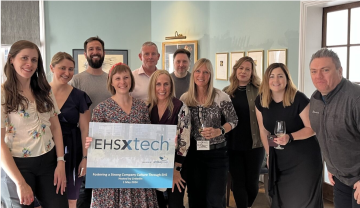As organizations embrace new technologies and shifting employee concerns, the future of Environmental Health & Safety (EHS) is evolving rapidly. Topics such as the rise of Artificial Intelligence (AI), workplace violence prevention, emergency response in the hybrid work environment, employee mental health and more are shaping the future of how EHS teams must adapt to support employee needs.
In November, EHS professionals gathered at a one-day EHSxTech event facilitated by Antea Group to discuss these issues and more. Hosted at Salesforce’s San Francisco office, the event theme was Building a Resilient EHS Program through Prevention and Monitoring. Together, professionals from 15 companies came together to explore how the above elements contribute to a resilient and forward-looking EHS program. Below, we give a look into these discussions.
Harnessing AI in Health and Safety
Karl Huntzicker, VP of Global Health and Safety at Salesforce, opened the conversation by highlighting how AI can revolutionize EHS programs. With tools like conversational AI, generative content creation, and predictive analytics, AI is redefining how EHS programs are managed, aiming to better support employees and improve program efficiency. For instance, virtual assistants can simplify interactions by helping employees access resources and report incidents through chatbot interfaces, improving both response times and data accuracy. By embedding AI directly into existing platforms, such as employee messaging systems, employees can seamlessly engage with safety resources through familiar channels.
This approach underscores the importance of aligning AI-driven tools with employees’ preferred communication methods to maximize engagement and ease of access. There will also be a process of “teaching” AI how we communicate, refining these tools over time so that they not only deliver information but do so in a way that resonates with employees on a personal level.
Generative AI supports EHS teams by automating content creation for training materials, inspection findings, and case management suggestions, allowing EHS professionals to focus on high-priority, hands-on tasks. Predictive AI, which leverages historical data, can identify trends and monitor real-time risks—such as using video surveillance to detect hazards—enabling proactive risk management. Ultimately, AI isn’t about replacing EHS professionals but rather about enhancing their ability to create safer, more responsive workplaces, and continuously improve program efficiency.
Workplace Violence Prevention Plan Implementation
Next, we held a panel discussion about the journies of two companies in attendance in implementing the new workplace violence prevention plan requirements in California. They discussed how clear roles and responsibilities are essential in managing workplace violence effectively. Misunderstandings about what constitutes workplace violence can slow down response efforts. That’s why it’s important for EHS programs to prepare employees for diverse scenarios, including harassment or physical threats, not just extreme events like active shooters. Training sessions and self-defense courses can empower employees to recognize and respond to various risks, increasing their preparedness.
Organizations can strengthen workplace violence policies by defining protocols for investigations, training employees, and gathering feedback. Including stakeholders from different departments ensures a comprehensive approach, especially when managing privacy-sensitive incidents.
Emergency Preparedness and Planning in Hybrid Work Environments
Next, in the facilitated discussions, the conversation moved to emergency preparedness. EHS teams are continually challenged by the need to meet emergency response requirements in hybrid work environments. This raises the ongoing question: how do you establish an effective emergency response team (ERT) when no one is in the office consistently, or the same people aren't present every day?
Companies are adapting protocols to address these nuances, working to maintain a responsive ERT without simply "ticking a box" for compliance. Incentivizing ERT participation through recognition events and specialized training sessions can foster a culture of preparedness, encouraging more employees to engage actively in ERT roles. This may include things like coordinating firehouse tours for participants, providing luncheons and award raffles, or offering other company perks and prizes.
In the discussion, two other innovative solutions emerged. TagEvac, a low-tech option, allows any employee to assume the fire warden role, marking that a floor has been cleared and swept. A more advanced option, would use employee badge data tied to proximity sensors in the office, enabling employers to identify who is onsite and track personnel locations during an evacuation. Other practical solutions for managing emergency response drills included tiered evacuation drills, allowing for partial evacuations by floor, and designating clear sweeping areas for each floor combined with the use of post-it notes on closed doors to indicate an area has been swept.
Organizations are also exploring technology’s role in enhancing emergency readiness. For example, AI tools could monitor evacuation routes, ensuring clear exits and providing valuable support during critical situations. By integrating these flexible, technology-assisted solutions, companies can meet emergency preparedness requirements effectively in the evolving hybrid work landscape.
Occupational Health and Psychosocial Challenges
While physical safety protocols are evolving, so too is the need to address psychosocial health challenges. Increased legislation around psychosocial requirements globally has led EHS professionals to reevaluate their support for occupational health programs. The concept of “carewashing”—offering wellness benefits without actively supporting employees—highlights the need for a shift from passive offerings to proactive care. By leveraging AI to identify psychosocial risks, such as analyzing excessive computer usage or PTO usage, companies can get a real-time view of employee stress levels, allowing for intervention before issues escalate.
Managing psychosocial risk and occupational health programs starts with defining key responsibilities between different stakeholder groups. As one attendee put it, “The fact that we don't know the roles and responsibilities surrounding psychosocial risks, is one of our top risks related to psychosocial risks." Structured roles, such as those defined through a RACI (Responsible, Accountable, Consulted, and Informed) model, can clarify who handles what in supporting employee well-being, so there are no gaps in support. EHS teams and other stakeholders, such as HR, must work together to assess psychosocial risk and ensure mitigation strategies are implemented. A proactive approach is essential, and training managers to recognize early signs of strain and providing mental health resources preventively, rather than reactively, creates a healthier workplace.
In crisis situations, having trained responders on hand is important to ensuring that any employees in distress receive immediate, qualified support. Where this isn’t possible, employees such as GSOC (Global Security Operations Center) personnel, though not emergency operators, may need to stay on the line until emergency services arrive, helping bridge critical moments until formal support takes over. From here, it’s also essential to consider the well-being of support staff who assist distressed employees, as Angie Dickson, Senior VP Antea Group asked, “Who’s take care of the people that are taking care of the people?”
Benchmarking Program Effectiveness Through Metrics and Stress Testing
Evaluating the effectiveness of an EHS program requires a combination of careful monitoring and proactive stress testing to ensure resilience. Incident reporting metrics serve as a foundational tool, enabling EHS teams to track trends, demonstrate value, and make data-driven decisions. By collecting both qualitative and quantitative data—from incident reports to employee feedback through surveys and training evaluations—teams can assess whether safety initiatives are meeting organizational objectives and effectively engaging employees.
However, monitoring alone is only part of the picture. To ensure programs are truly resilient and adaptable, regular stress testing is essential. Benchmarking and conducting both internal and external audits help identify gaps and areas for improvement, especially in younger or leaner EHS programs. Stress-testing initiatives through real-life scenarios and table-top exercises and simulations can provide valuable insights into program maturity and help prioritize future actions.
Together, these methods—monitoring through metrics and continuous stress testing—create a comprehensive approach that aligns EHS goals with broader business objectives and secures support from leadership and stakeholders. This dual approach not only evaluates program effectiveness but also reinforces a culture of holistic safety.
Key Takeaways
In summary, navigating the future of EHS requires a balance of technology, psychosocial understanding, and proactive strategies. To achieve success, companies must consider the following:
- Embrace AI Thoughtfully: Use AI to complement safety efforts without overwhelming employees with new tools.
- Determine Roles and Responsibilities: Defining roles and implementing diverse training fosters readiness for workplace hazards such as violence prevention or psychosocial risk management.
- Adapt Emergency Plans for Hybrid Work: Tailor protocols and maintain engagement for a culture of readiness.
- Prioritize Psychosocial Health: Address psychosocial risks with structured support, rather than relying on passive resources.
- Monitor and Measure Program Success: Data-driven metrics strengthen the effectiveness and alignment of EHS programs with organizational goals.
- Build Resilience Through Testing: Regular stress-testing prepares EHS programs for unexpected challenges and supports long-term growth.
By integrating these strategies, organizations can cultivate a workplace culture that prioritizes safety, well-being, and adaptability. EHS teams, empowered by clear metrics, proactive care, and the latest AI innovations, are well-positioned to build resilient, future-ready safety programs.
Interested in attending our next event? Connect with us to learn more.
Want more news and insights like this?
Stay in the loop with our monthly e-newsletter, The New Leaf. We’re here to keep you informed, enlightened, and entertained with the latest in EHS and sustainability. Don’t miss out on the insights and stories that matter to you!✨ Ready to turn over a new leaf? Sign up now!
Have any questions?
Contact us to discuss your environment, health, safety, and sustainability needs today.






